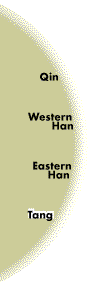

This ox figurine with a human body and an animal head represents one of the twelve animals associated with the Chinese zodiac: the rat, ox, tiger, rabbit, dragon, snake, horse, goat, monkey, chicken, dog, and pig. They symbolize the individual years of the Chinese twelve-year cycle and the twelve two-hour periods into which the Chinese divided the day. Animals were first used to signify the twelve-year cycle during the Warring States period (475-221 BCE). By the Sui (581-618) and Tang dynasties they were engraved on funerary steles and around the edges of epitaphs.
